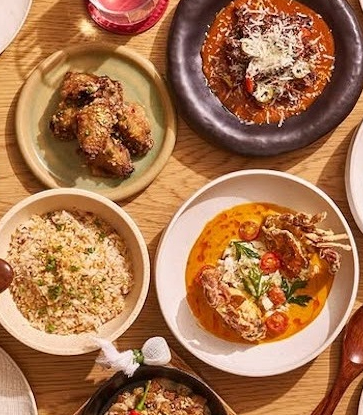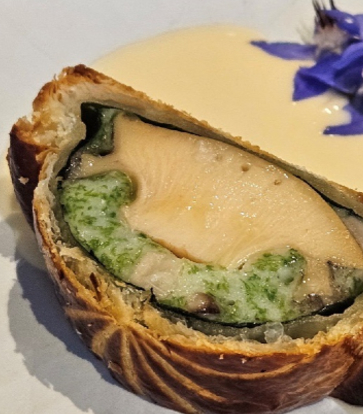
Ten years later, Lim met three other passionate foodies, chef Justin Quek, Ignatius Chan and Chong Yap Seng. At a time when fine dining was the exclusive purview of hotel restaurants, the quartet mooted an idea: together, they would open Singapore’s first standalone fine dining restaurant.
And thus, local icon Les Amis was born.
Since then, the restaurant has grown from strength to strength, culminating in its recognition as a two-Michelin-starred restaurant earlier this year. In the process, the fine dining iconoclast and the team behind it have evolved into a well-oiled machine, expanding aggressively locally and overseas. Today, Les Amis is part of a larger restaurant group that bundles in over 20 concepts such as mass market Vietnamese pho chain NamNam Noodle Bar and buzzing French-style eatery Bistro du Vin.
All this, following the success of a single restaurant and the passion of a few gentlemen.

Now 59 and chairman of the Les Amis Group, the famously media-shy Desmond Lim sits down with The Michelin Guide Singapore Digital at Les Amis’ chef’s table – a private room with a glass window that looks into the kitchen. As the brigade de cuisine tidies up after lunch service, Lim, who wears a white short sleeved shirt and an earnest smile, tells us the group’s story and how he grew, step by step, from the man who drove from one Michelin-starred restaurant to another, to the visionary leader of a thriving restaurant group.
The Genesis of An Icon
“I felt that there was a gap - something missing in the dining scene here,” says Lim. Back then, the only fine dining restaurants in Singapore were part of bigger luxury hotels.
“The main idea was to have an independently owned and run restaurant outside the hotels,” he says.
“I had the two people with the right skill sets and I was the main financier. On a realistic level, you could call it a case of talent meeting capital, but even before that, it was about like-minded people who wanted to achieve the same aim.” That is, to fashion a restaurant based on the standards they experienced at the top restaurants in France.
Les Amis quickly became the talk of the town. Its name translated from French means ‘The Friends’ – a nod to the founders' coming together.

It was hip, trendy ,and quickly became the place to see and be seen in the late 1990s. What started off as a one floor space naturally grew. In 2007, Les Amis nearly doubled in size with the addition of a mezzanine floor. The restaurant took over the lease of turning Shaw Centre’s second floor retail space and turned it into private dining rooms.
The bill? S$2.5 million. And that’s just for one renovation.
The Costs of Fine Dining
Lim doesn’t mince his words when it comes to the costs of running a fine dining establishment. He rejects being called a restaurateur saying that he’s a full time stockbroker. When numbers are brought into the conversation, one catches a sliver of the financier in him.
“Anybody who wants to open a restaurant - especially fine dining, especially today - needs to get his head examined,” he says with a chuckle. “Unless your family can foot the bill, it’s very, very tough. Fine dining anywhere globally is tough.”
“Look at the ratio of staff to the covers that you do. Then, you have to keep things fresh. Every three to four years you need to touch up. Every five to six years you need a major renovation,” he shares, as though mentally checking off lists.
There are also structural factors that the customer doesn’t see, like the cost of air-conditioning and fitting out the kitchen. “On the kitchen alone, we recently spent $600,000, and almost $400,000 on new equipment, cutlery, crockery, staff. It’s expensive.”

And just as you’re settling into the notion that he really is hard-nosed numbers man, he says: “Even the cost of food – most places operate at 30 to 35 per cent of total cost, and maybe 34 to 36 per cent for fine dining outfits. We are way above 40 per cent, so it really is a labour of love and pride. It is great branding and there’s pride of ownership as well. You cannot convert that kind of stuff into dollars and cents.”
“[Les Amis] started off as a passion and as is every business, you hope to make some money along the way, but I didn’t go into the business with that focus,” says Lim.
The Software
At that point of the interview, a suited member of staff slides the door open and places a basket of warm madeleines on the table. The smell of melted butter wafts through the air.
“This is from our pastry chef Cheryl Koh,” he says. Koh is just one of the many culinary whizzes to have emerged from Les Amis' kitchens. Indeed, the restaurant’s longevity means that its kitchens have turned out some of Singapore’s best talents.
Jason Tan of Corner House, Sufian Zain of Waku Ghin and dessert doyenne Janice Wong are just some of the more accomplished names. Others include Gunther Hubreschen of Gunther’s, and of course not forgetting the fact that Justin Quek and Ignatius Chan have both gone on to open Michelin Guide-listed Sky on 57 and Iggy’s respectively.
“A great restaurant is always about software,” says Lim. “So that has always been our philosophy: to attract and retain the best.”

Ironically, he has never had to go out of his way to woo potential culinary stars. Instead, chefs and line cooks come their way, attracted to the restaurant group’s prestige and firm commitment to gastronomy.
This is not limited to aspiring Singapore chefs but also to global names, allowing culinary knowledge and skills to be transmitted beyond borders. Executive chef Sebastien Lepinoy for instance, is one such. The Frenchman had been working at three-Michelin-starred L’atelier de Joel Robuchon in Hong Kong for 16 years before he decided to move to Cépage, the group's now-defunct one-starred restaurant in Hong Kong, and then to Les Amis.
It's a far cry from when they first started out. Back then, not only was there a lack of fine dining restaurants, the local talent pool, too, was limited. “It wasn’t as sexy [an industry] as compared to what it is today. You didn’t have all these young kids wanting to be chefs. It was more about bread and butter and earning a living. In those very early days, people don’t talk about passion."
Being in Asia and tapping on an Asian talent pool to cook French cuisine also turned out to be a double-edged sword. Lim admits that while Asians generally did not grow up eating French cuisine or dining in upscale restaurants, Asian chefs are more attuned to the Asian palate, which make up the bulk of the diners in Singapore.

“You have to tweak the food a little bit without sacrificing its authenticity and soul,” he says. “This skill is something you can learn. The Asian culture is a lot harder to learn - but if you work hard, you study hard, you can. The best man will be represented in the kitchen.”
While training is left to the kitchen team leads, the restaurant’s management does take the initiative to fly the culinary team abroad to dine. This lets the team experience the food and service at renowned Michelin-starred restaurants – a luxury that the staff might not otherwise get.
Staying Friends
Such investments are not small. How then does he react when someone leaves?
“I believe in letting people go when they have to – they should be able to fly as high as they can,” he says. “If there is no more opportunity to grow, we shake hands and wish them all the best. You cannot retain them for selfish reasons. Maybe down the road, our paths might cross again.”
In some cases it has – and to mutual benefit. Popular Vietnamese pho eatery NamNam Noodle Bar is one such case in point.

“Credit must be given to chef Nam,” says Lim, referring to Vietnamese chef Nam Q Nguyen, who was the head chef of The Lighthouse, a restaurant under the Les Amis Group up till 2003.
“Nam was with us for two years and we stayed in touch even after he left the group. We touched base six to seven years ago, when he was sharing the idea of starting a casual Vietnamese noodle concept with me. We became his backers.”
Today, NamNam has a growing Southeast Asian presence, and will add Manila into its footprint by end of this year. Other brands in the Les Amis Group’s portfolio that have gone abroad include Peperoni Pizzeria and Shabu Shabu Gen.
The group will also be opening a second Les Amis in Kuala Lumpur in the middle of 2017, making it Singapore’s first Michelin-starred restaurant export.
“The operating environment in Singapore is tough, there’s a lot of competition and an oversupply of eateries,” he says. “In Singapore, if there is an opportunity, we will expand but the growth for us is overseas.”
Still, that doesn’t mean he doesn’t have an eye on refining the existing concepts here. When asked if he’s gunning for a third star for his flagship, he says: “I would be lying if I said I wasn’t. Everybody would love that but nothing will change at Les Amis. Our core values and what we believe in will stay for as long as I remain the owner."
Even so, he shies away from common praise of the restaurant as a torchbearer for Singapore’s dining scene. “I wouldn’t go as far as to say we contribute to Singapore’s food scene. Of course, for our own reasons we want the best for Les Amis," he says. "Along the way, given our 20 odd years of history, we have grown a large alumni and we’re very proud that they spent a part of the career with us, not just the half dozen of those who made it to the limelight but many of those in junior positions too."
Through its challenges and its successes, Les Amis, it seems, has truly kept to its creed - as a place for friends, run by friends. lesamis.com.sg.






















